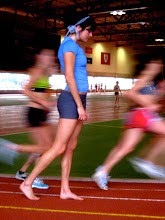Consistent massage for the muscles keep them supple and ready for their highest performance in any athlete's progress. Whether you weight lift or do underwater basket-weaving, your muscles deserve the most blood flow possible in order to get the job done efficiently and it's peak strength, right? Yes. Here are some tools and tips on how to approach the process properly that you might want to hold onto for your post-run, activity, or for the day you happen to feel like a senior citizen.
The Stick / "Rolling Out" (the dough)
This quite literal 'stick' focuses on releasing muscles knots by applying pressure on the region, through an up and down motion breaking down tightness and increasing blood flow. Go too hard and you'll cause the muscle to tense, thus defeating the purpose of muscle elongation. Keep your pressure relative to what the area can take. You should feel like you can relax your muscles as the stick is being used. The suggested time for this is ten minutes per leg. My tid bit of a tip: hold the stick on the white bearings to get a more efficient "roll out". It's like rolling out dough: do it too much, the dough breaks to loss of functioning abilities, do it the point of relaxation it'll elongated and got more surface area to work with. Make sure to stretch after the fact because your muscles will be nice and warmed up.
I started this with teammate Madi and it has since caught on in our team and to other teams including soccer and basketball.

 (pictured: IT band and lower calves or the soleis muscles -- when loose they prevent achilles tendonitis)
(pictured: IT band and lower calves or the soleis muscles -- when loose they prevent achilles tendonitis)The Foam Roller
Recommended for a lighter release of muscle tightness in the IT (illotibial muscle and tendon that runs from the side of your hip to the knee) band, quads, calves, hamstrings, groin, gluts (what credits the apple bottom jeans), and the upper and lower back. The IT band, in particular, can be hard to stretch so this is especially helpful as you allow yourself to judge the amount of pressure necessary with your own body weight, using your arms as a way to support yourself in each position. A back and forth motion from the top to bottom of the muscle is motion seen. Laying on your back upon it is a thorough way to get things loose and cracked before or after a run.

The Pipe
This is a PVC pipe that can be specially cut at your local hardware store.
I wouldn't prescribe this until you have graduated from the foam roller -- you'll know this when it feels like it's only comfortably massaging rather than breaking tension with a dash of pain. It's extremely helpful for the gluts (the largest muscle in the human body that require the most pressure) and the hamstrings (which in my opinion comes second to the gluts in massivness). Deep pressure is required for the densest. Shown here it's used for the calves and IT band.

 (pictured: calves and IT band)
(pictured: calves and IT band)The Golf ball/ The Tennis Ball
These guys can be used just about anywhere, conquering a knot or general tightness that is too intricate to address via the roller, the stick, or hands. They are great for isolating the area and creating different directions to work out the muscles. Instead of doing an up and down motion that I have suggested, use it to horizontally right to left. The muscle is not used to this motion and will be extra responsive to this motion since it is rarely felt. You can also try circular motions. They are excellent for the foot whose nerve endings and muscles are usually overlooked and thus neglected. Injuries like plantar fascitis, a common tendonitis of the foot, can be remedied by such. I also strongly recommend using this right above the gluts, lower back, hips, and groin. It's best to play around and figure out what feels best. Suggested time: 2 minutes - 5 minutes; too much can cause breakdown and loss of the muscle's intended function.


(pictured: the foot and calves with a golf ball)
Hands/Elbows
They can be used anywhere, customizing the pressure and precision of what needs attention. I again recommend horizontal left to right motion, circular motion, and static pressure. The elbow is great for the gluts and hamstrings when nothing else can make a dent. The best is for a willing teammate, friend help you out so everything can relax and you'll get more out of the session. I also recommend Boston Body Works at Copley Square and the Boston Running Center in Washington Sqaure for quality massage therapy.
I found this article in the NYTimes that was very resourceful for today's runner yet it only scratched the surface in explaining why and how massage therapy can relieve muscle inflexibility. I hope this helps! Please feel free to ask questions.

No comments:
Post a Comment